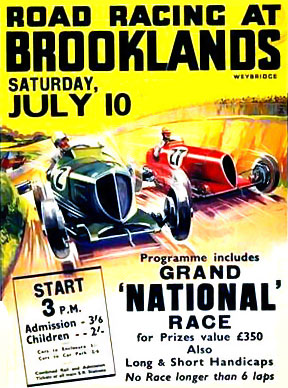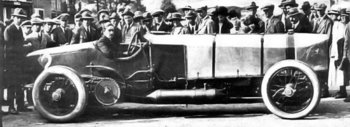Brooklands
Brooklands is a disused motor racing circuit built near Weybridge in Surrey, England. The brainchild of Hugh Locke-King, it was opened on June 17 1907 and was the first custom-built banked motor race circuit in the world. It was the first ever oval style race track built for cars.
Requirements of speed and spectator visibility led to the track being built as a 100 ft wide, 2.75 miles long, banked oval. The banking was nearly 30 feet high in places. In addition to the oval, a bisecting "finishing straight" was built, increasing the track length to 3.25 miles, of which 1.25 miles was banked. It could host up to 287,000 spectators in its heyday.
Due to the complications of laying tarmac on banking, and the expense of laying asphalt, the circuit was built using gravel and cement. This led in later years to a somewhat bumpy ride, as the surface settled over time.
Along the centre of the track ran a dotted black line, known as the Fifty Foot Line. By driving over the line, a driver could theoretically take the banked corners without having to use the steering wheel.
Eleven days after the circuit opened, it played host to the world's first 24 hour motor event, with Selwyn Edge leading three specially converted Napier cars around the circuit. Over three hundred red railway lamps were used to light the track during the night. Flares were used to mark the upper boundary of the track. Edge drove his car for the full duration, with the drivers of the other two cars taking the more familiar shift approach.
Grand Prix motor racing was established at Brooklands in 1926 by Henry Segrave after his winning of the French Grand Prix in 1923 and the following year at the Spanish Grand Prix which raised interest in the sport in Britain. This first British Grand Prix was won by Louis Wagner and Robert Senechal driving a Delage 155B.
During the late 1930s, Brooklands also hosted massed start cycle racing events organised by the National Cyclists' Union (as the sport's governing body, the NCU banned such events from public roads).
When World War II broke out in 1939, racing was stopped due to fuel rationing. After the war completed in 1945, it was deemed that racing cars were too fast for the banking, and no further racing took place.
Brooklands Airfield
Brooklands also became one of Britain's first airfields. In 1908 it hosted the first flight of an English aircraft by an English pilot, Alliott Verdon-Roe. In the summer of 1910, Hilda Hewlett and Gustave Blondeau opened Britain's first flying school at Brooklands. Hewlett and Blondeau also started their aircraft manufacturing business on site before moving to larger premises at Leagrave, Bedfordshire. In February 1912, Thomas Sopwith opened his Sopwith School of Flying and, in June 1912, Sopwith, with several others, set up the Sopwith Aviation Company here, although their main premises were at Kingston upon Thames. Bleriot, Martinsyde, and Vickers later set up production at Brooklands. Many flying schools operated here before 1914 and the aerodrome was a major flying training centre between the wars.
In World War II, the site was again used for military aircraft production, in particular the Vickers Wellington and was extensively camouflaged. Trees were also planted into the concrete of the circuit to help screen the Hawker and Vickers aircraft factories there. From 1944-72 Vickers (and later BAC) also used nearby Wisley aerodrome which offered a longer runway and less built-up surroundings.
After the war, the circuit was in poor condition and was sold to Vickers-Armstrongs in 1946 for continued use as an aircraft factory. New aircraft types including the Viking, Varsity, Viscount, Vanguard and VC10 were next manufactured and delivered from there.
In 1951, a section of the race track's Byfleet Banking was removed to allow Vickers Valiant V-bombers to be flown out to Wisley.
The Vickers factory became part of the new British Aircraft Corporation in 1960 and went on to design and build the BAC TSR.2, One-Eleven and Concorde. The factory contracted in size in the mid-1970s and finally closed in 1988-89.
In 1987 the site also become home to the Brooklands Museum, which is dedicated to the site's motoring and aviation heritage.
Present day
The remaining sections of track were the subject of a preservation order in 2001, rendering illegal any subsequent destruction of the circuit. From 1990 to 2003 regular fly-ins, rallies attended by light aircraft, were arranged on summer weekends using the Northern half of the original runway. The central area of Brooklands including the hard runway and remaining racetrack was sold to DaimlerChrysler UK Retail in early 2004. A Mercedes-Benz museum and performance demonstration centre is now completed in front of the remaining banking. Mercedes-Benz World opened to the public on 29 October 2006 and incorporates a test track that includes the banked track of the Clubhouse turn. The facilities also include a conference centre, hotel and a Mercedes-Benz showroom. Other stores which reside on the small retail park include a Tesco, Marks & Spencer, Mothercare, Currys and Argos.
Brooklands made a TV appearance when it featured in a 1990s episode of Agatha Christie's Poirot when Hercule Poirot investigates a crime committed involving a racing driver. The banking of Brooklands was also used as a 'road location' in an episode of The Bill where the CID foiled an armed robbery and resulted in a 'shoot out'.
People associated with Brooklands
- Henry Birkin
- John Cobb
- Malcolm Campbell
- Henry Segrave
- George Eyston
- Kaye Don
- Frank Halford
- Hilda Hewlett
- Kishichiro Okura
- J.G. Parry-Thomas
- Thomas Sopwith
- Count Louis Zborowski
External links
- The Brooklands Society
- Brooklands Museum
- Mercedes-Benz World
- The River Wey and Wey Navigations Community Site — a non-commercial site of over 200,000 words all about the Wey Valley including information and images about Brooklands, Weybridge and early automobile manufacture in England
- Google Maps Aerial View
- Kaye Don at Hampton Wick

